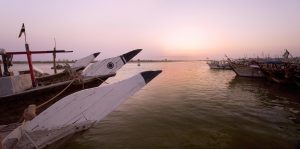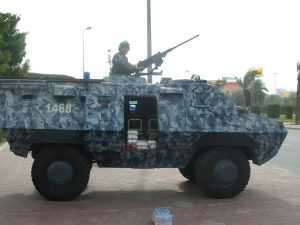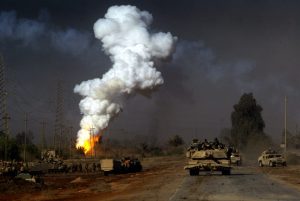21 North Africa & the Middle East: Historical Geography II – Iraq Wars
Modern-day Iraq evolved as a result of World War I and the subsequent collapse of the Ottoman Empire. Britain colonized many of the former Arab territories of the Ottomans. In setting the boundaries of Iraq, it created a multinational colony containing three major cultural groups. Northern Iraq was dominated by the Kurds, a non-Arab, mostly Sunni Muslim people. The rest of Iraq was predominantly Arab, but with a major religious division. The central portion of Iraq was dominated by Sunni Muslim Arabs, while southern Iraq was populated mainly by Shia Muslim Arabs. Today, Shia Arabs account for more than half of Iraq’s population. About a third of Iraqis are Sunni Arabs, and most of the remaining population are Kurds.
The British granted Iraq home rule in the 1920s, and the country gained full independence in the 1930s. Over the next few decades, a combination of oil wealth, government expenditures on infrastructure, and generous social welfare programs transformed Iraq into a regional economic power with relatively high standards of living. Politically, though, Iraq was always somewhat chaotic. Governments changed frequently, and even those that survived for a fair amount of time were plagued by political in-fighting. Ethnic discord was common. Iraq’s ever-shifting foreign policy managed to alienate it from nearly every other government in the region. And, at the height of the Cold War, Iraq’s government embraced socialism, but also imprisoned and executed thousands of Iraqi communists. As a result, both the United States and Soviet Union were wary of aligning with Iraq, leaving the country with few political allies in the wider world.
Iraq’s political situation began to stabilize somewhat in 1968, but not for especially good reasons. The Sunni Arab-dominated Ba’ath Party seized control of the country in a military coup. The country’s new vice president was Saddam Hussein, who also headed Iraq’s secret police. Hussein used the state security apparatus to quickly eliminate his political opponents, both outside and within the Ba’ath Party. By the early 1970s, although still not president, he was clearly the most powerful person in Iraq. When Hussein formally assumed the presidency in 1979, Iraq was at the height of its economic prosperity, but his ascent to power marked the beginning of a forty-year period when Iraq would be at war more often that it wasn’t.
The Iran-Iraq War
In 1980, Iraq launched a surprise invasion of Iran. Saddam Hussein had long argued that Iraq should “retake” territory it had been denied by British-sanctioned colonial boundaries. As Iran’s Islamist revolution sent that country into chaos, Saddam Hussein moved to seize the region of Khuzestan.

Khuzestan is an Iranian province that borders the eastern bank of the Shatt al-Arab, a waterway where the Tigris and Euphrates rivers flow into the Persian Gulf. Its seizure would have meant significant economic and geopolitical gains for Iraq. The Shatt al-Arab is Iraq’s only coastal outlet, and controlling both sides of it would secure Iraq’s ability to export oil by sea. Khuzestan is also rich in oil, and would have significantly increased Iraq’s share of the region’s reserves. To legitimize the invasion, Hussein argued that Khuzestan’s predominantly Arab population should be part of Arab Iraq, and not Persian Iran. He further argued that the invasion was necessary to prevent Iran’s new government form exporting its brand of Islamic militancy throughout the region.
As mentioned above, both the United States and the Soviet Union had a frosty relationship with Iraq’s government for many years, but they both supported Iraq’s invasion of Iran – a rare instance when the Cold War superpowers were in agreement. The United States was adamantly opposed to Iran’s new rulers, who had recently overthrown the American-backed government, holding a number of Americans hostage in the process. The U.S. also feared the spread of Iran’s Islamist revolution to its Muslim allies in the region. The Soviets feared the same for its largely Muslim republics in Central Asia. Most of the rest of the international community, with the exceptions of Syria and Libya, lined up behind Iraq as well.
Iraq had more money, greater political stability, and a far more potent military arsenal than Iran, but Iran had a much larger population. Casualties were heavy, particularly on the Iranian side, which sent wave after wave of soldiers directly into the teeth of the Iraqi military. After some initial gains, Iraq’s advance into Khuzestan stalled. By 1982, Iran had pushed the Iraqis back to the prewar border, and the war settled into a stalemate of trench warfare that resembled the bloody battlegrounds of World War I, with deadly frontal assaults and poison gas attacks, but with little progress on either side.
Eventually, Iran opened a second front along its border with northern Iraq. It enlisted the support of Iraq’s Kurds, who rebelled against Hussein’s government. By 1988, Iraq was forced to negotiate a ceasefire. The war ended with practically no change in territory, but with staggering losses. Khuzestan was virtually obliterated. Estimates vary, but Iraq is believed to have lost about 300,000 military personnel in the conflict, while Iran may have lost more than half a million, including scores of child soldiers forcibly conscripted into the conflict. About 100,000 civilians, mostly Iranian, were killed as well. In the closing days of the war, Saddam Hussein punished the Kurds for their rebellion. Bombardments and chemical weapons attacks killed more than 50,000 Kurds, most of them civilians.
The Persian Gulf War

The war with Iran devastated Iraq’s economy, but also left it with a huge military force – the fifth-largest standing army in the world. Saddam Hussein, still wanting to seize more oil, and to open a broader window on the Persian Gulf, turned his attention to Iraq’s tiny neighbor, Kuwait. His argument was familiar – that Kuwait, a predominantly Sunni Arab state, was unfairly separated from Iraq by British imperialism. He also made unfounded claims that Kuwaitis wanted to be liberated from their government.
In 1990, Iraq invaded Kuwait, and occupied it within a matter of days. Kuwait’s small military was obliterated. More than 4,000 Kuwaiti fighters were killed in the first few hours of the conflict. Kuwait’s royal family fled the country, and hundreds of thousands of Kuwaiti refugees poured over the border into Saudi Arabia. Iraqi soldiers plundered Kuwait City, and a puppet regime was installed. By conquering oil-rich Kuwait, Saddam Hussein had doubled Iraq’s oil reserves practically overnight, and now controlled a fully operational deep-water port on the Persian Gulf.
Hussein had, apparently, expected little pushback from the international community, as had been the case when he invaded Iran a decade before. That was not the case. Unlike Iran, Kuwait was a close ally of the United States and a number of other key western countries. Kuwait was also an Arab state, and Hussein’s unprovoked invasion infuriated much of the Arab world. Both Saudi Arabia and Egypt, the leading Arab states, immediately condemned the invasion, as did the United States and the Soviet Union. Much of the international community feared Iraq would invade Saudi Arabia next, giving Saddam Hussein control of more than a third of the world’s oil, as well as the holy Muslim cities of Mecca and Medina.
Action against Hussein’s regime was quick and decisive. The United Nations authorized the use of military force, the first time it had done so since the Korean War. A coalition consisting of nearly a million troops, primarily from the United States, Britain, France, Saudi Arabia, and Egypt, assembled on the Arabian Peninsula. The coalition liberated Kuwait within a matter of days, and invaded southern Iraq. At the behest of the United States, Iraq’s Shia Arabs and Kurds rebelled against Hussein’s government. In March, 1991, a ceasefire was signed. Estimates of Iraqi military deaths ranged as high as 50,000, while coalition forces suffered fewer than 200 fatalities.
As the brief war drew to a close, U.S. President George Bush made the controversial decision not to send American troops all the way to Baghdad to topple Hussein’s regime. Bush feared that removing Hussein from power would destabilize Iraq, and that American troops would be forced to remain in the country for years to come.
The Iraq War

After the Gulf War, the victorious coalition imposed two major conditions of surrender on Iraq. First, it was not permitted to develop weapons of mass destruction, such as chemical, biological, or nuclear weapons, and would have to submit to regular United Nations weapons inspections. Second, it had to respect military no-fly zones in the northern (Kurdish) and southern (Shia) portions of Iraq. Over the next decade, Hussein’s government repeatedly violated those conditions by sending military aircraft into the no-fly zones, and by interfering with UN weapons inspectors. Hussein also launched a series of vengeful assaults on his country’s Shia and Kurdish populations – punishments for having rebelled during the Gulf War. As many as 100,000 Shias and Kurds, mostly civilians, were killed.
In 2001, with the election of President George W. Bush, the son of the president who had overseen the Persian Gulf War, the United States took a more aggressive tone toward Iraq. Many members of George W. Bush’s administration apparently disagreed with his father, and believed that Saddam Hussein needed to be removed from power. After the terrorist attacks of September 11th, 2001, the Bush administration became even more strident about Iraq. American officials said they had evidence that Hussein’s government was developing weapons of mass destruction, including nuclear weapons. They also argued that Hussein had coordinated with al-Qaeda, the Islamist organization that had carried out the September 11th attacks. The first argument seemed plausible, as Hussein’s government was still interfering with UN weapons inspectors. The second argument seemed somewhat far-fetched. As the leader of a secular military government, Hussein likely despised al-Qaeda nearly as much as the United States did.
The United States invaded Iraq in 2003. Unlike the Persian Gulf War, the United States was unable to build a monolithic coalition of support from the international community, and did not seek or receive United Nations approval. Major Arab powers supported the invasion, but with considerably less enthusiasm. A number of Western powers, notably Britain, Australia, and Poland, lent military support to the invasion, but many key American allies, including France, Germany, and Canada, were highly critical of the U.S. for not fully exploring diplomatic solutions.
The invasion was initially a success. Baghdad fell quickly, and the United States formed an interim Iraqi government. Saddam Hussein and many key Ba’ath Party officials were forced into hiding. Many of them, including Hussein, were eventually captured and executed by the new Iraqi government. Just six weeks after the invasion, the United States declared an end to major combat operations. No weapons of mass destruction were ever discovered.
What happened next was precisely what the first President Bush had feared back in 1991. With Hussein deposed, Iraq descended into chaos. Beginning in 2004, Sunni Arab insurgents began to carry out deadly attacks against the new Iraqi military, and against U.S. and coalition troops. Assaults on Shia Arab “collaborators” were particularly fierce. Iraq’s Shias quickly formed militias to retaliate, and an endless cycle of revenge killings plunged Iraq into civil war.
Fighting would rage for the next four years. In 2007, the United States dramatically increased its military presence in the country, and was able to stabilize the situation. Afterward, the U.S. began a steady withdrawal of troops, with the last American military bases officially closing in 2010. Over the course of the war, nearly 5,000 members of the coalition forces, primarily American and British troops, were killed. Approximately 100,000 Iraqi combatants died, along with 100,000 Iraqi civilians.

Since the official end of the war, the Iraqi government has been relatively unstable, lacking cohesion among its Sunni Arab, Shia Arab, and Kurdish factions. Only the Kurds, who have been granted an autonomous region in northern Iraq, and who are becoming increasingly prosperous, seem to have benefitted from the war. Sunni Arab and Shia Arab militants are still armed, and still fight occasionally. Some of the Sunni militias that evolved during the war went on to join the Islamic State. For many, the Iraq War has never fully come to an end.
Did you know?
My Turn!
CITED AND ADDITIONAL BIBLIOGRAPHY:
Pitcher, Jason. Erbil, Kurdestan, Iraq. Photo, 3 Sept. 2012. Flickr, https://www.flickr.com/photos/47563830@N06/8034675814/. Attribution-NonCommercial-NoDerivs 2.0 Generic (CC BY-NC-ND 2.0).
RNW.org, Kuwait (February 2003). Photo, 3 Feb. 2003. Flickr, https://www.flickr.com/photos/rnw/2989191598/. Attribution-NoDerivs 2.0 Generic (CC BY-ND 2.0).
Wasili. Dark Iraq. Photo, 17 Sept. 2007. Flickr, https://www.flickr.com/photos/timecollapse/1396999134/. Attribution-NonCommercial-NoDerivs 2.0 Generic (CC BY-NC-ND 2.0).
youngrobv. Iran Abadan _DSC19304. Photo, 27 Apr. 2008. Flickr, https://www.flickr.com/photos/youngrobv/2691663203/. Attribution-NonCommercial 2.0 Generic (CC BY-NC 2.0).


